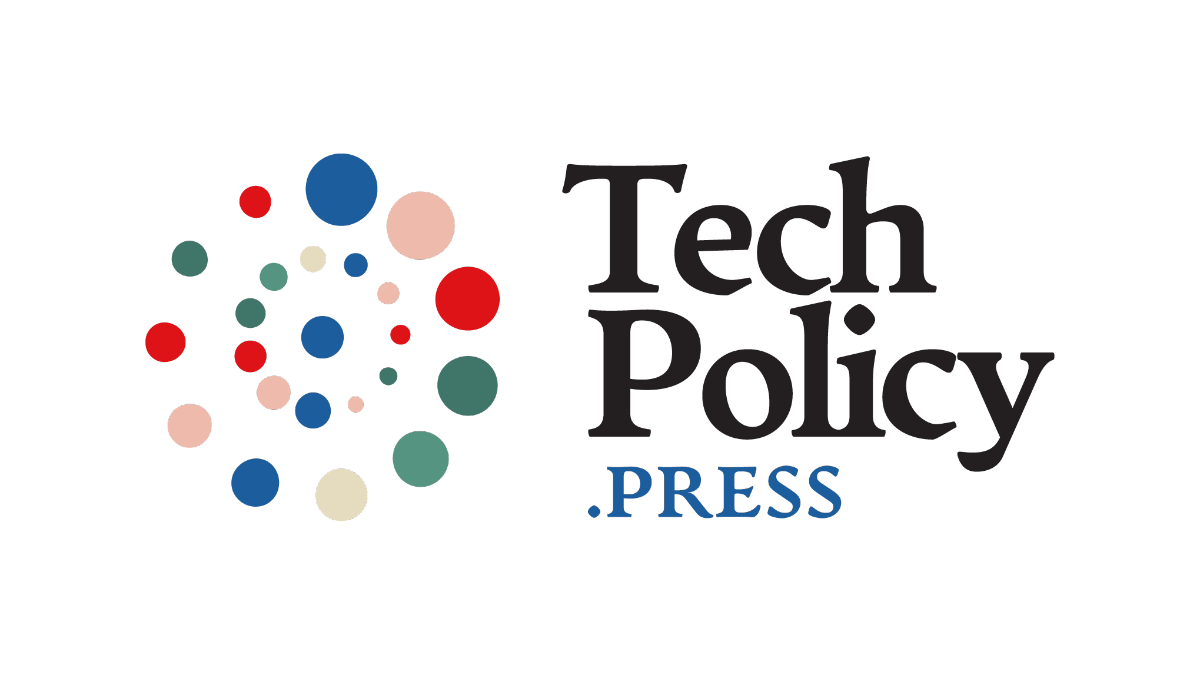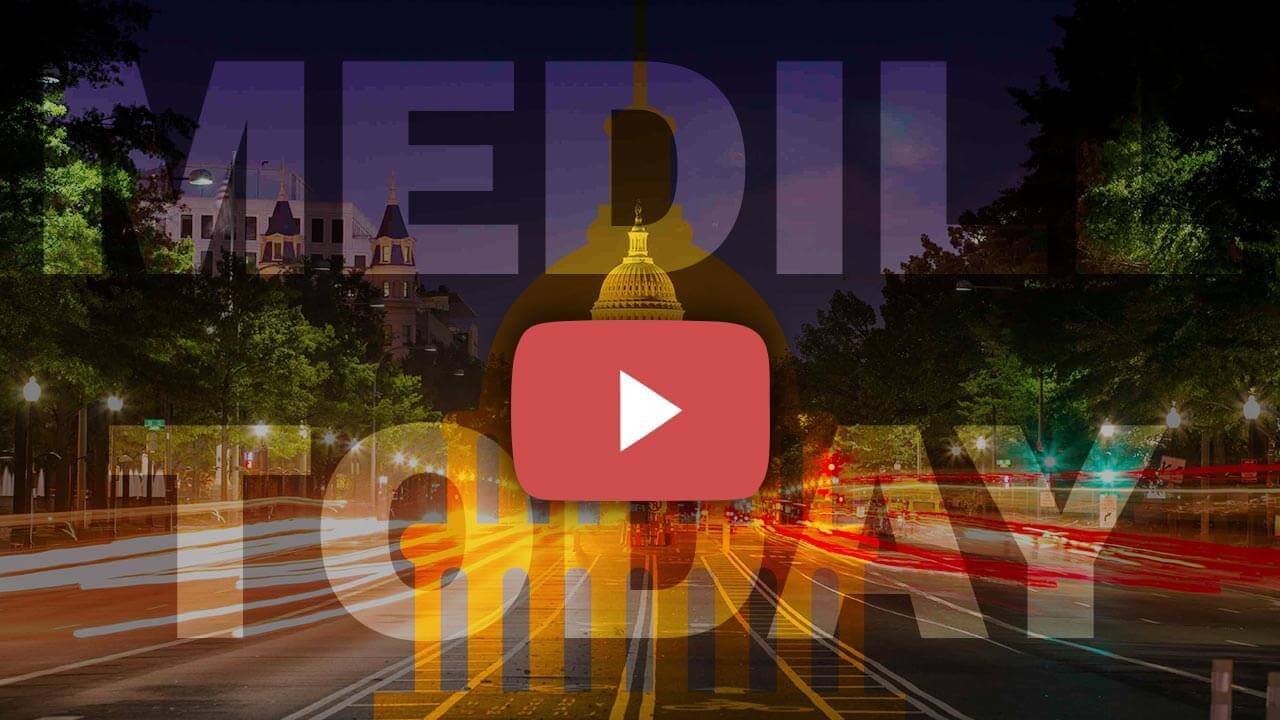Latest in Business News
Get up-to-date business news from our reporters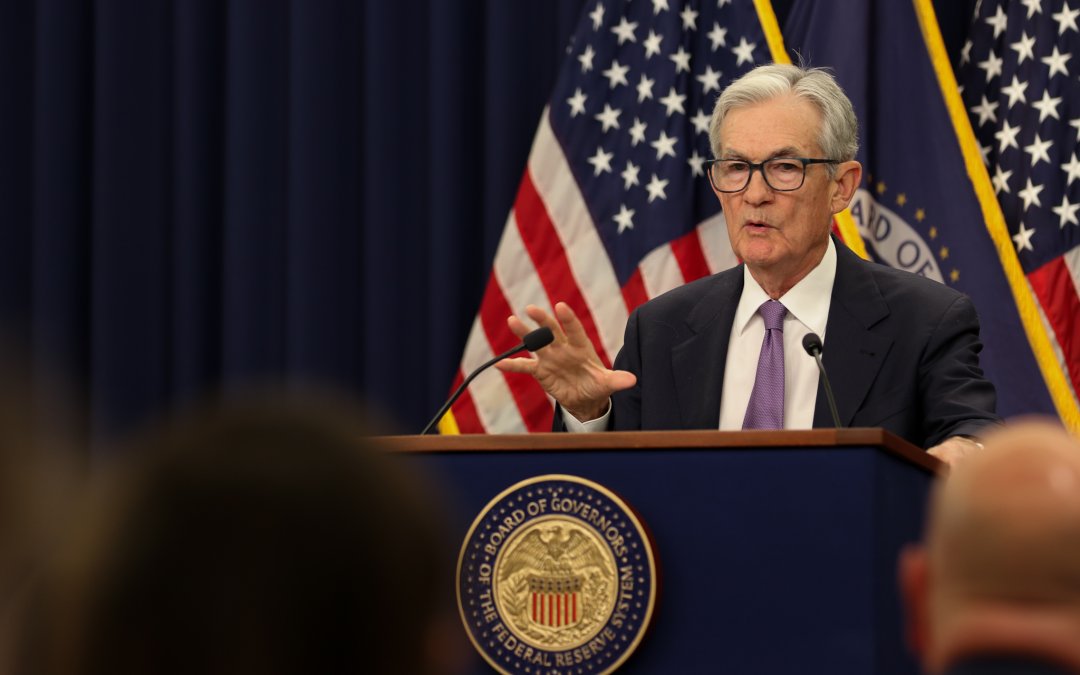
Fed cuts rates amid labor concerns, casts doubt on further easing in December
Fed Chair Powell said the employment and inflation outlook did not deviate much since the September meeting, but the shutdown forced the Fed to make a decision with only partial data.
read more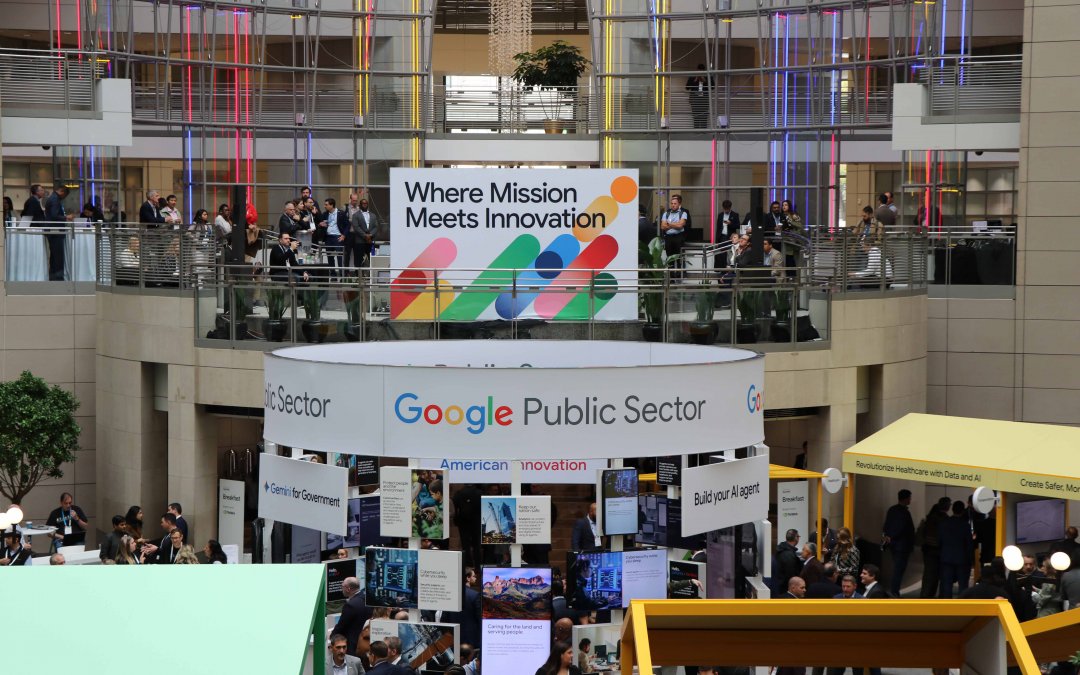
Photo essay: Google hosts Public Sector Summit for government leaders
Government workers from federal, state and local agencies convened to discuss Google’s newest AI innovations.
read more
WATCH: Small business owners bear the brunt as shutdown enters second month
Local businesses in Washington are grappling with decreased sales and slow foot traffic as shutdown pressure mounts.
read more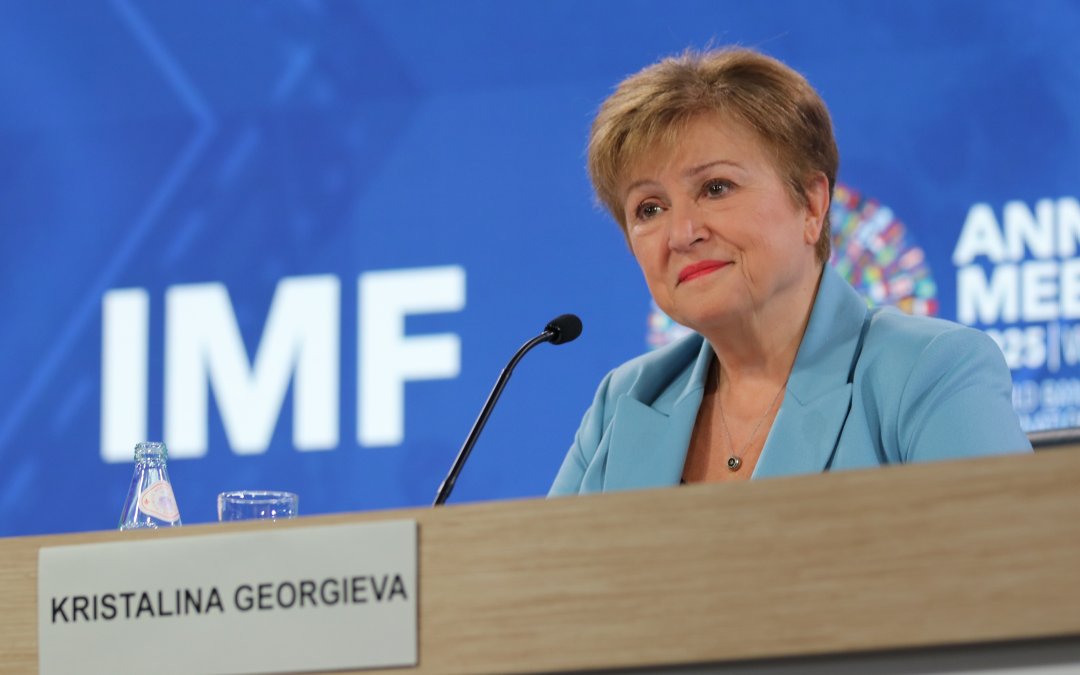
In Photos: World Bank, IMF leaders convene for annual meetings
This year’s meeting emphasized the effects of tariffs and artificial intelligence on the economy.
read more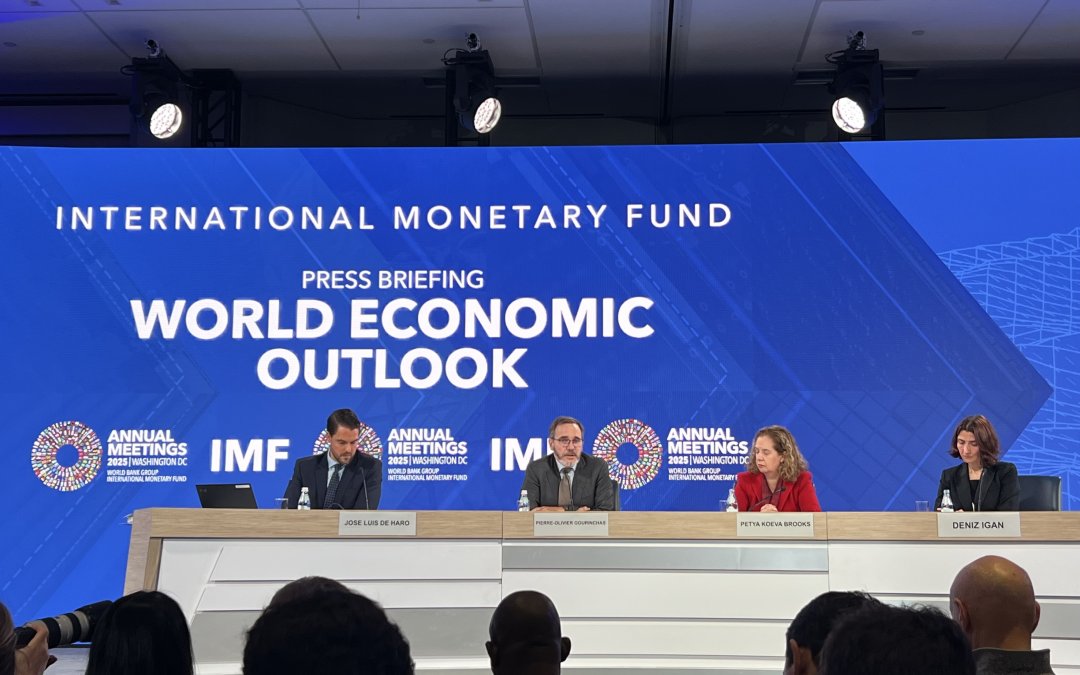
IMF projects stronger-than-expected global economy, cautions against ‘premature’ conclusions on tariff shock
The IMF released its latest World Economic Outlook amid escalating trade tensions between the U.S. and China.
read moreSenate debates merit of Patent Eligibility Restoration Act
WASHINGTON — One day after questioning Attorney General Pam Bondi during a highly televised Senate Judiciary Committee hearing, Sen. Mazie Hirono (D-Hawaii) attended a much quieter discussion before a smaller audience on Wednesday.
“This is like a normal hearing,” Hirono said at the Intellectual Property subcommittee hearing. “It’s nice.”
The debate focused on the Patent Eligibility Restoration Act (PERA), which would expand patent eligibility in sectors including software and biotechnology. It aims to combat Supreme Court decisions from the 2010s that limited patent applications on diagnostics, software and business methods.
PERA advocates argue that such patent restrictions discourage innovation and investment in these emerging industries.
Subcommittee chair Thom Tillis (R-N.C.) has held hearings on the subject since 2019. He introduced the bill in 2023 with Sen. Chris Coons (D-Del.) as a co-sponsor.
Tillis announced in June that he would not seek re-election in 2026 and acknowledged during the hearing he had limited time to push PERA forward.
“Under my watch, which, incidentally, is over the next 452 days, it will be one of my top priorities in my office,” he said.
Former U.S. Patent and Trademark Office director Andrei Iancu said uncertainty in the patent system is “deadly,” referring to courts striking down patent applications on diagnostics. He said these denials limit disease detection options for consumers.
And Steven Caltrider, Chief IP counsel at the Dana-Farber Cancer Institute, said patent restrictions discourage private sector investment that helps the diagnostics come to fruition.
American University assistant law professor Charles Duan said in an interview with Medill News Service most PERA advocates come from larger pharmaceutical and tech firms.
“A lot of patent law comes down to who you think are the most important people in terms of who develops innovations,” Duan said.
Testifying on behalf of genetic testing companies, Pillsbury, Winthrop, Shaw & Pittman LLP partner Richard Blaylock said patents allow firms to privatize medical discoveries.
“PERA would slam the door shut on access to new biomarkers,” he said.
Making biomarkers patent-eligible would also harm patients, Blaylock said. Diagnostics test for a variety of biomarkers, but requiring permission from patent holders to perform those tests will put up roadblocks to critical care.
Duan said expanded patent eligibility leads to monopolies and reduced competition. Consumers experience that impact through higher prices and limited options.
That point was also raised by Mike Lemon, who testified on behalf of the National Retail Federation.
“Every dollar businesses spend fighting frivolous lawsuits is a dollar they cannot put toward lowering prices, hiring staff or improving service,” Lemon said.
For Mark Cohen, a senior technology fellow at the Asia Society of Northern California, international competition looms behind domestic impacts.
Cohen said China’s broadened patent laws give it a competitive advantage over the U.S. That could turn into a national security concern, he said, when technology is used for military purposes.
But Lemon said PERA would make it easier for foreign companies to apply for U.S. patents, allowing China to maintain its lead in the innovation race.
Still, combatting Chinese markets is a priority for Tillis.
“They represent a threat to Western democracy and open capitalist markets,” Tillis told Medill News Service. “To be honest with you, this is about always pacing ahead of China in my mind.”
Witnesses agreed on advancing American innovation. Even disagreements on how to best do so did not escalate.
“One of the beautiful things about patent law, Sen. Coons, is that it’s nonpartisan or bipartisan,” Iancu said.
Senate hearing on Biden-era censorship shifts to debate on Trump administration threats, Kimmel suspension
WASHINGTON – Lawmakers and witnesses emphasized the threat government censorship poses to First Amendment rights in a Senate Commerce hearing Wednesday, with Republicans referencing Biden officials’ censorship of social media and Democrats focusing on the current weaponization of free speech by the Trump administration.
The hearing followed an investigation led by Committee Chairman Ted Cruz (R-Texas) on the Cybersecurity and Infrastructure Security Agency (CISA)’s role in “jawboning” big tech companies into disproportionately silencing conservative viewpoints during the Biden presidency. The practice of jawboning refers to the “inappropriate demands made of private actors by government officials,” according to a paper published by the Cato Institute.
In a report outlining the investigation, the Committee found that CISA “acted outside both the First Amendment and its own authority” by conducting a censorship campaign of “constitutionally protected speech.” The Supreme Court reviewed these censorship claims in a 2024 case Murthy v. Missouri and sided with the Biden administration in a 6-3 ruling, citing that the plaintiffs lacked sufficient standing to sue.
“This hearing is a farce,” Sen. Ed Markey (D-Mass.) said. “We are not focusing on the imminent threat to the First Amendment, the beating heart of democracy.”
Markey noted that the Committee is “re-litigating an issue that the Supreme Court has already decided” and focused his questioning on the ongoing threats made by the Trump administration to revoke media outlets’ access and licenses based on their “editorial decisions.”
Senate Democrats also tailored their remarks and questioning to Federal Communications Commission (FCC) Chair Brendan Carr’s role in the temporary suspension of Jimmy Kimmel’s late night show. In an appearance on Benny Johnson’s podcast last month, Carr said, “We can do this the easy way or the hard way,” in reference to ABC and local affiliates. Hours later, ABC announced it was pulling Kimmel’s show.
Ranking Member Sen. Maria Cantwell (D-Wash.) outlined the chain of events that led to the pre-empting of Kimmel’s show following his comments on Charlie Kirk’s assassination and argued that they should “alarm every American.”
“I think indeed the remarks made by Chairman Carr seemed to be an attempt at coercion,” said Eugene Volokh, senior fellow at Stanford University’s Hoover Institution. “Whether or not they actually caused the suspension of Jimmy Kimmel, they were an attempt to do something the Constitution does not allow.”
“I certainly hope that Chairman Carr does come here to testify,” said Sen. Ben Ray Luján (D-New Mexico). “There’s several of us that have authored legislation to protect [the First Amendment] and maybe it’s something that can become bipartisan.”
In his testimony, CEO and Co-Founder of conservative magazine The Federalist Sean Davis claimed that the “defenses of media millionaires like Jimmy Kimmel are based more on partisanship than any sort of actual belief in free speech.” Davis testified on CISA’s role in “directing and funding censorship efforts” based on the outlet’s criticism of the government and media response to the COVID-19 pandemic and the Black Lives Matter (BLM) moment.
Kirk’s assassination itself also emerged as a recurring topic among lawmakers and witnesses, with Davis describing his murder as an example of the rippling effects of censorship.
“It begins with censorship, it moves to the destruction of statues and monuments, and it ends with the murder of people,” Davis said.
Despite intense debate and divided opinion on Biden and Trump censorship campaigns, Luján acknowledged that “there is a lot of agreement” within the Committee.
“I don’t know anyone in that room that disagrees with protecting the First Amendment…no one,” Luján said.
The Committee will continue ongoing discussions on free speech protections and has invited Carr to testify before a panel over Kimmel’s suspension. A hearing date has not yet been announced.
Government shutdown leaves policymakers, economists in the dark on ‘jobs Friday’
WASHINGTON – From Washington to Wall Street, policymakers and economists await the release of the monthly jobs report, published by the Bureau of Labor Statistics (BLS) on the first Friday of every month, commonly known as “jobs Friday.”
This past Friday morning, October 3, however, the anticipated economic release was replaced with something else —an announcement on the BLS website regarding the “suspension of federal government services.”
The government shutdown halted nonessential services across several agencies, including the production of economic data by the BLS. That meant a delay in September’s employment report.
The last time a government shutdown delayed the jobs report was in 2013, and the report was released a few weeks later once the government reopened.
The jobs report provides Americans a snapshot of employment trends, drawing upon two primary surveys: Current Employment Statistics (CES) and Current Population Survey (CPS). The CES program or “establishment” survey tracks metrics such as payroll, hours worked and wages earned. The CPS or “household” survey tracks labor force characteristics such as participation, unemployment rate and demographic factors.
“I think the jobs report is the most personal part of the economy,” said Tom Beers, executive director of the National Association for Business Economics (NABE). “It’s who’s working and who’s not, and it allows you to put your own life into that perspective.”
In addition to helping individuals keep track of the national employment situation, the jobs report informs critical policymaking, namely that of the Federal Reserve. The central bank relies on employment data, among other metrics, to determine the path forward for interest rates.
A cooling labor market coupled with above-target inflation has left the Board of Governors in a precarious position regarding interest rate cuts. The delayed September jobs data makes their job even harder.
“Sometimes (the jobs report) may be the only data that the Fed or business decision makers have on the previous month when they’re trying to make a call on something,” Beers said. “They’ll have to look elsewhere to piece the story together.”
Alternative sources of data include a private-sector employment report from payroll processor Automatic Data Processing (ADP) as well as proprietary data from the Carlyle Group, an alternative asset management firm.
While the Federal Open Market Committee (FOMC) announced a 25-basis-point reduction at last month’s meeting, St. Louis Federal Reserve Bank President Alberto Musalem emphasized the need to “tread cautiously.”

St. Louis Federal Reserve Bank President Alberto Musalem discusses economic and monetary policy at Brookings. (Courtesy of The Brookings Institution)
“Overemphasizing the labor market objective runs the risk of excessive policy easing,” Musalem said. “Overemphasizing the inflation objective runs the risk of not providing enough support to maintain a full employment labor market at a time when downside risks have risen.”
BLS reports may be in limbo during the government shutdown, but the Trump administration’s attacks on the data’s integrity poses a roadblock for the agency even after the government reopens.
In a statement following the BLS’s annual benchmark revisions in September, the White House argued for the need to “restore Americans’ trust in the data after years of inaccuracy that has misled policymakers and eroded confidence.”
According to Elise Gould, a senior economist at the Economic Policy Institute, the value of the Bureau’s data “cannot be overstated.”
“The politicalization of that data can be harmful to public trust and the agencies themselves,” Gould said. “Federal employees have come under attack and the loss of workers could impact the quality and timeliness of the data that’s provided.”
Nearly one week into a government shutdown and a Federal Reserve meeting on the horizon, lawmakers have reiterated the need for this data as well.
In an interview with Medill News Service, Sen. Chris Van Hollen (D-Md.) said, “Donald Trump has undermined the integrity of that report and it’s essential that it be done by nonpartisan federal employees. We hope we can resume getting it as soon as possible.”
Lawmakers, witnesses convene amid government shutdown to debate reform of cryptocurrency tax code
WASHINGTON – The Senate Finance Committee debated the fairness and transparency of current cryptocurrency tax policy on Tuesday, seeking to advance President Donald Trump’s agenda of global leadership in the industry.
The hearing proceeded on the first day of the government shutdown, prompting pushback from Democrats who criticized the Republican majority for diverting attention from the funding lapse.
Sen. Elizabeth Warren (D-Mass.) expressed concern that the Committee convened to “discuss anything other than this Republican shutdown and stopping Donald Trump from throwing 15 million people off their health care.”
Warren acknowledged the hearing’s purpose of improving clarity on cryptocurrency tax regulation and plugging “crypto tax loopholes.”
Increased transparency and reform on taxation of digital assets drew bipartisan support at both yesterday’s Finance Committee hearing and the House Ways and Means Oversight Subcommittee’s session held in July.
Jason Somensatto, director of policy at the Coin Center, advocated for “rules that align crypto transactions with comparable activities under the law” as opposed to “special treatment.”
One of the main burdens companies and consumers experience with respect to cryptocurrency is its treatment as property by the Internal Revenue Service (IRS), rather than traditional currency. When a consumer uses cryptocurrency even for small transactions, such as to buy a coffee, it “triggers a complex taxable event,” according to Somensatto.
“This is comparable to tax obligation every time you send an email or a text message,” Somensatto said.
Vice President of Tax at Coinbase Lawrence Zlatkin explained a possible resolution to this matter in his testimony, citing the de minimis exemption. The rule permits the exclusion of low-value transactions from capital gains taxation.
“The Code already includes a de minimis rule for foreign currency,” Zlatkin said. “Digital assets should be treated the same way.”
Somensatto and Zlatkin’s statements on simplifying cryptocurrency transactions via the de minimis rule garnered mixed reactions from lawmakers.
In his opening remarks, Chairman Mike Crapo (R-Idaho) said that “lingering tax uncertainty also makes the U.S. a less attractive place to do business and invest.”
Warren, on the other hand, called into question the fairness of this rule and requested clarification from Andrea S. Kramer, founding member of ASKramer Law, LLC.
“If someone bought $300 worth of gold, or $300 worth of Apple stock, would they be required to report any income they made from those transactions?” She added, “If crypto investors get this de minimis exemption would they pay less in taxes than traditional stockholders for precisely the same kinds of transactions?”
Kramer responded affirmatively to both questions.
“Every one of these special rules tilts in the same direction—and that is for anyone investing in crypto to pay less than the equivalence elsewhere in the financial system,” Warren argued.
In an interview with Medill News Service, Warren reiterated that crypto lobbyists are “not spending money to get the same rules,” but rather, “they’re spending money to get special treatment.”
Annette Nellen, who chairs the Digital Assets Tax Task Force at the American Institute of CPAs, acknowledged the necessity of tracking transactions for the “sake of compliance.” At the same time, she urged Congress and the Treasury to “consider the need to minimize the tax administrative burden and to maximize the amount of clarity for taxpayers, tax practitioners, and the IRS.”
Aligning with President Trump’s priority for the “United States to lead the global digital currency revolution,” Sen. Steve Daines (R-Mont.) emphasized the importance of swift action on clarifying digital asset tax laws and that “guessing will stall growth” of U.S. advancement.
On congressional action regarding cryptocurrency, Securities and Exchange Commission Chair Paul Atkins noted “uncertainty” and “tax efficiencies” in the space but “commends Congress for looking into and addressing these issues.”
Trump tariff delays cause market uncertainty, experts say
WASHINGTON — Tariff uncertainty and delays have become the norm under the Trump administration.
President Donald Trump announced a 100% import tax on pharmaceutical drugs Sept. 25. He also proposed levies on select kitchen cabinets, upholstered furniture and trucks that same day.
The tariffs were set to take effect on Wednesday, but the White House released a memo on Tuesday pushing the implementation date to Oct. 14.
Such a postponement came as no surprise to Tinglong Dai, a professor at the Johns Hopkins University Carey Business School. Dai said he’d be more shocked if the tariffs were implemented on time.
“Trump Always Chickens Out — it’s not just a joke,” he said, referring to TACO, an acronym associated with previous tariff delays.
Although Trump aims to increase domestic manufacturing through these levies, Dai said the proposals are often impractical for producers, causing delays in implementation. Building new factories, for instance, comes at the cost of disrupting established supply chains.
It’s also unclear to which firms some tariffs apply, as evident in Pfizer’s drug pricing deal with Trump on Tuesday.
The agreement, a three-year exemption from the proposed 100% tariffs on pharmaceutical drugs in exchange for more investment in U.S. manufacturing, leaves the door open for other pharmaceutical companies to avoid import taxes.
“In general, the policies are not fully thought out in terms of the details of how they’ll be implemented,” American University economics department chair Kara Reynolds said.
And it’s consumers who bear the brunt of changing price levels that arise from tariffs, House Democratic Caucus Chair Pete Aguilar (D-Calif.) said in a press conference Wednesday.
“It’s terrible for the markets, but more importantly, it hurts people,” Aguilar said.
Former World Trade Organization chief economist Robert Koopman said firms tend to invest less in volatile environments. And decreased investment worsens consumer confidence.
So while tariffs do not cause recessions, they often contribute to less consumer spending, Koopman said.
“That uncertainty is probably worse than the tariffs themselves,” he said.
There’s also uncertainty in the reasons behind certain tariffs. The Trump Administration justifies most of them under Section 232 of the 1962 Trade Expansion Act, a law that allows restrictions on imports threatening national security.
Recent proposals push the limits of that authority, Brookings senior fellow Elena Patel said.
“It’s a stretch of the imagination to understand how kitchen cabinets and bathroom vanities affect national security,” said Patel, who also co-directs the Urban-Brookings Tax Policy Center.
Dai said tariff announcements on seemingly arbitrary goods brands the U.S. as a “reckless” country that does not consider economic policy consequences.
Trade partners will turn to different markets instead, he said. This isolates the U.S. and undermines Trump’s intent to turn the nation into a manufacturing hub.
“Overnight, we have really lost that brand, being an economic power,” Dai said.
But he sees a silver lining in Trump’s lengthening list of tariffs despite looming economic consequences.
“As he keeps surprising consumers and also manufacturers, I think his ability to surprise the market is going to be less and less because we have seen this before,” Dai said.
Kimmel show fallout prompts concerns over free speech, FCC influence in broadcasting
WASHINGTON – Jimmy Kimmel returned to the air Tuesday night after Disney-owned ABC suspended the late-night show following his remarks on the assassination of conservative activist Charlie Kirk and Federal Communications Commission Chair Brendan Carr’s threats to the network.
In his opening monologue, Kimmel thanked fans and fellow talk-show hosts, including Stephen Colbert, Jimmy Fallon and Jon Stewart. He also made note of the support received from politicians such as Sen. Ted Cruz (R-Texas) and Sen. Rand Paul (R-Ky.), stating “it takes courage for them to speak out against this administration, and they did.”
Kimmel’s nearly weeklong suspension sparked intense backlash across the political spectrum and concerns over press freedom.
In a statement to Medill News Service, Rep. Judy Chu (D-Calif.) stated that “the Trump administration tried to silence a critic by abusing federal power, and a major network caved.”
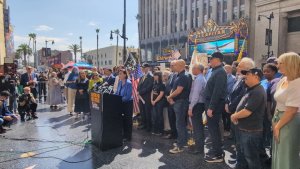
Rep. Judy Chu (D-Calif.) speaking at a press conference organized by Rep. Laura Friedman (D-Calif.) outside the Jimmy Kimmel Live! studio in Hollywood. (Courtesy of the Office of Rep. Chu)
“That only changed because millions of Americans spoke out in defense of our constitutional right to free expression,” Chu said.
Disney’s decision on Sept. 17 to suspend the show indefinitely followed Carr’s comments on “The Benny Show,” a right-wing podcast. Carr called Kimmel’s remarks about Kirk the “sickest behavior I’ve seen yet” and stated “these companies can find ways to take action on Kimmel, or there is going to be additional work for the FCC ahead.”
Hours before ABC pulled the plug on Kimmel, local television station owners Nexstar and Sinclair announced that they would be pre-empting Jimmy Kimmel Live! with other programming.
Nebraska Republican Representative Don Bacon said in a statement that “the threats FCC Chair Carr made were a mistake” and “the Constitution does protect our speech from government restrictions,” but noted that “ABC and its affiliates have every right to make their own determinations.”
Kimmel’s suspension is another example of the Trump administration’s willingness to pressure media companies and take legal action against them. In December, ABC agreed to settle a defamation lawsuit brought by Trump for $15 million. In July, Paramount announced a $16 million settlement over the editing of a CBS News “60 Minutes” interview, a month before the FCC approved its $8 billion merger with media company Skydance.
Most recently, a judge dismissed a lawsuit against the New York Times, accusing the media platform of being a “leading, and unapologetic purveyor of falsehoods” against the President.
Trump’s efforts at media suppression have called into question the press’s ability to exercise free speech. But, according to Brent Skorup, a legal fellow at the Cato Institute, broadcasters are subject to different limitations.
“The Supreme Court held decades ago that, essentially, broadcasters do not have the full First Amendment rights that most media have,” Skorup said. “Because they use spectrum and are licensed by the FCC, it can investigate, including fail to renew and reject, license applications.”
Skorup noted that while Carr’s comments were a “violation of free speech norms,” the FCC is “fairly free to scrutinize content” under current law.
Carr later reiterated that Kimmel’s suspension was a result of programming decisions made by media companies.
ABC brought Kimmel back on air on Sept. 23, but the show did not run on Nexstar and Sinclair-owned stations.
Nexstar, which owns nearly 30 ABC-affiliated stations, is currently awaiting FCC approval on a roughly $6 billion merger with another local television station owner, TEGNA.
According to Skorup, there is a “long practice” of merging companies being sensitive to FCC concerns.
“Nexstar has to get approval from the FCC for the merger, and they actually have to get an exception to the current cap on ownership of stations,” said Stuart Benjamin, a professor of law at Duke University, specializing in the First Amendment.
“The concern is if [Nexstar] doesn’t do what Brendan Carr wants, then maybe the FCC doesn’t raise the caps or delays raising the caps by a couple of years,” Benjamin said. “And if you delay long enough, then you effectively prevent the transaction from happening.”
Skorup says Kimmel’s suspension could prompt wider conversation about free speech rules with respect to broadcasting, noting he’d “welcome” a lawsuit that would reevaluate those rules.
“It would be a great thing for the Supreme Court to recognize broadcasters as full-fledged members of the media with full First Amendment rights,” Skorup said. “But, for the parties who are in the best position to sue, like broadcasters, no regulated party is eager to sue the agency that licenses them.”
SALT debate lies ahead for Congress as high-tax state residents and reps look for tax relief
Before tax accountant Jack Hahne moved from Atlanta to New York City in 2022, the state and local tax deduction cap, commonly known as the SALT deduction cap, hardly concerned him.
“I was making a little bit less money, so it wasn’t something I was particularly concerned about because it wouldn’t really impact me very much,” Hahne said.
But Hahne could no longer be indifferent following his move to a state with a much higher tax burden. His cost of living expenses and salary rose in New York, as he expected. But when he sat down to file his taxes, he realized he could only deduct $10,000 of his state and local taxes from his taxable income.
The 2017 Tax Cuts and Jobs Act, the Trump administration’s sweeping tax bill, placed a $10,000 cap on the state and local taxes that taxpayers could deduct from their taxable income. If this cap did not exist, Hahne’s itemized deductions, eligible expenses that could be written off his taxable income, would be greater than the standard deduction, which was a flat amount he could deduct.
With the SALT deduction cap enacted, Hahne would not benefit from itemizing his taxes: The cap pushed his potential itemizations under the standard deduction amount, which stood at $14,600.
From Hahne’s calculations, without a SALT deduction cap, he would have saved about $300 out of the $29,000 he paid in taxes last year.
“It’s not something that is a huge impact immediately,” Hahne said. “As I plan to get married, settle down, have kids and all that … it is something that is going to become more and more of an issue for me just as I plan out my life going forward.”
The debate over SALT has been heating up among high-tax state residents and lawmakers because the 2017 Tax Cuts and Jobs Act is set to expire at the end of 2025. During Trump’s 2024 election campaign, he pledged to repeal the same cap he signed into place, but the future of SALT is anything but certain.
SALT Caucus Republicans have taken up a key role in the tax debate as the reconciliation process is underway. These lawmakers hold the power to stall the passage of any tax policy sought by the rest of the GOP. In late February, House Republicans allocated $4.5 trillion for tax cuts in their budget resolution but it is unclear how SALT reform will fit into the broader tax cuts.
Future changes in SALT policy would dictate which parts of the nation would receive a sizable percentage of the allocated tax cuts. If the cap increased, many residents of high-tax states would experience a drop in their tax burden. However, this change may come at the expense of other tax or spending cuts nationally, or increase the budget deficit.
Who’s impacted by the SALT cap?
The SALT deduction cap became a cornerstone issue for many New York, New Jersey and California lawmakers. They have expressed frustration that middle-class residents of high-tax states are bearing the burden of the cap.
“This clearly impacts the middle class, the working class so that’s why we’re focused (on it),” Rep. Mike Lawler (R-N.Y.), a member of the SALT Caucus, said to Medill News Service.
Only 10% of taxpayers opted for itemized deductions in 2020, according to the Tax Policy Center. State and local taxes fall under the umbrella of itemized deductions.
However, the changes to SALT policy impacted a much broader group of Americans than just those currently filing for the deduction.
The number of people who took itemized deductions, consequently the SALT deduction, significantly fell after the Tax Cuts and Jobs Act passed. The act doubled the standard deduction and capped the SALT deduction, making itemized deductions less profitable for more Americans. In the 2020 tax year, 90% of taxpayers opted to take the standard deduction compared to only 70% of taxpayers in 2017, the year before the changes went into effect, according to the Tax Policy Center.
Critics of SALT deductions still argued that only the wealthiest Americans faced significant tax hikes because of the cap.
“There’s pretty minimal to no benefit for those in the bottom 60% of incomes nationally. So it is sort of distributed more to the upper-income groups,” said Garrett Watson, the director of policy analysis at the Tax Foundation.
Those most likely to be affected by the change fall in the upper-income thresholds. High-tax states’ residents and representatives argued, however, that there is a significantly different definition of who qualifies as middle class versus wealthy in different states.
“Wealth is a very subjective thing because in my district if you’re a police officer married to a nurse, you’re making $250,000 or $300,000 a year,” Rep. Tom Suozzi (D-N.Y.), who is a co-chair of the SALT Caucus, said to Medill News Service. “Where we live on Long Island, the houses are so expensive, the taxes are so high that you’re really just a middle-class person … whereas if you’re making $250,000 or $300,000 a year in Oklahoma, you belong to a country club and you live in a gated community.”
Shaker Nelanuthala, an IT project manager and volunteer for Suozzi’s campaign, faced the scenario that Suozzi described. Nelanthala, who lives on Long Island, said his household earned an annual income of approximately $200,000, putting him in the top 20% of wage earners nationally, according to The Washington Post.
For Nelanthala, who described himself as upper-middle class, the SALT deduction cap had hurt him significantly. He lost $25,000 in deductions to his taxable income.
“The middle-income people, they’re the ones that are basically getting impacted a lot,” Nelanthala said. “When you add up (taxes), it is a significant amount.”
What is the impact on the budget?
Raising the SALT deduction cap would not be costless for the federal government. If the federal government decided to double the cap to $20,000, federal tax revenue would decline by approximately $225 billion over the next 10 years, according to the Tax Policy Center. The loss in revenue would be even greater if Congress decided to eliminate the cap, allowing for unlimited SALT deductions. This lost revenue would amount to approximately $1.2 trillion.
Advocates against raising the cap argued that changing the SALT policy could come at the expense of other tax cuts.
“By definition, each additional dollar that Republicans are giving to high-income taxpayers in these high-tax areas is $1 less that can go to keeping America’s business tax code competitive, incentivizing investment and jobs coming back to America, to keeping tax rates low for all taxpayers, for keeping the Child Tax Credit reforms,” said Adam Michel, the director of tax policy at the Cato Institute, a libertarian think tank. “If these salt members extract a large dollar value for whatever they need on the SALT cap, it means you get less of all the sort of pro-growth generally applicable non-tax cuts.”
Andrew Wilford, a senior policy analyst at the National Taxpayers Union Foundation, argued that Congress should instead focus on “broad-based” tax reform that “benefits taxpayers broadly” rather than a “very small group of wealthy taxpayers.”
Is it fair for high-tax states?
The debate over SALT corresponded with a fight over whether these high state tax rates were justified.
For most Republicans, regardless of their take on SALT, these high-tax, often Democratic-leaning states behaved recklessly with their tax rates.
For pro-SALT Republican representatives, the past SALT deductions acted as relief for their constituents from these high-tax rates.
“My mayor and governor keep hammering taxpayers to death. … This really is a problem created by the city and state,” said Rep. Nicole Malliotakis (R-N.Y.), who is a member of the SALT Caucus, to Medill News Service. “We’re doing what we can to try to provide some relief on the federal level.”
Conservative advocates against SALT argued the cap acted as a check on state governments, pushing them to lower their taxes rather than “subsidizing” their tax bill.
“It’s almost like a discount on your state tax bill. That’s something that enables and encourages states to increase their taxes because they’re able to tell their wealthiest residents that they can just write it off at the federal level,” Wilford said.
However, the notion that low-tax red states had previously subsidized high-tax blue states is misleading.
William Gale, the co-director of the Urban-Brookings Tax Policy Center, agreed the SALT deduction cap mainly hurt high-income taxpayers in high-tax states. He said the policy, however, heightened a disparity between the amount that high-tax, Democratic-leaning states give to the federal government compared to how much they received back in federal spending.
“The blue states do pay more, and this exacerbates that imbalance,” Gale said.
States such as New York, New Jersey and California received less federal funds from the federal government than they paid in 2021, according to the Washington Post, which is not indicative of a subsidy from red states. Additionally, from 2018 to 2022, blue state taxpayers contributed nearly 60% of all federal tax receipts but received only 53% of all federal contributions to states, according to Time.
Local advocates for SALT argued that, because of the federal imbalance in spending, state and local spending has become integral for the wellbeing of local communities.
“Local taxation is so unique because those dollars go straight back into the community, and folks can really see the benefit,” said Dante Moreno, the manager for legislative advocacy for the National League of Cities. “State and local control … is very much in the 10th Amendment of the Constitution. There is supposed to be an amount of state and local control, especially because (the governments) are the most beholden to our constituents.”
There is little evidence that states and localities have shifted their tax policies because of the 2017 SALT deduction cap. However, some tax policy experts are concerned that if a cap became permanent, states may opt to lower their taxes, which could hurt the most vulnerable communities reliant on state and local programs.
“If that limitation on state revenues then affects what states can spend, then you have to look at who benefits from the state spending,” Gale said. “If you think about what the state spends money on its education and health care and transportation and stuff like that, then you can at least form a judgment that some groups that benefit from education and health might end up being hurt by the cap.”
The future of SALT?
The House passed a budget resolution on Feb. 25, 2025, that included $4.5 trillion in tax cuts for the next 10 years. Yet, the plan for future tax cuts has not been finalized since the budget is currently being debated in the Senate and Congress has not decided how tax cuts will be allocated.
It remains unclear how the SALT Caucus will manage to squeeze their relief in, given that the president placed significant pressure on Congress to extend his 2017 tax cuts, which would cost $4.2 trillion over the next 10 years alone, according to the Treasury Department.
However, considering the slim Republican margin in the House, the SALT Caucus may have an oversized impact in the debate over tax cuts. The Republicans cannot afford to lose many votes on a tax bill if the Democrats remain united, with a slim 218-213 majority.
Some SALT Caucus Republicans vowed to vote against any bill with insufficient changes to the cap.
“Without a fix to the cap on SALT, I will not support a tax (bill),” Lawler said to Medill News Service. “So it will be part of the final package.”
A penny for your thoughts: what’s next for the one-cent coin?
WASHINGTON — President Donald Trump proposed removing the penny from U.S. circulation in February.
The one cent coin costs the U.S. Mint about 3.7 cents to make. Will discontinuing the coin contribute to higher costs and inflation or save the government millions of dollars?
Watch the video report here:
Strategic bitcoin reserve signals Trump administration’s increased loyalty to cryptocurrency industry
On the campaign trail, President Donald Trump made a promise to the cryptocurrency entrepreneurs that they have not forgotten: a pledge to be the first “crypto president.”
Last week, Trump took his latest in a string of actions to align himself with the digital asset industry by establishing a strategic bitcoin reserve in an executive order.
“I promised to make America the bitcoin superpower of the world and the crypto capital of the planet,” Trump said at the White House cryptocurrency summit. “We’re taking historic action to deliver on that promise.”
A strategic bitcoin reserve would consist of bitcoin that the federal government seized, according to the executive order. Under the order, the U.S. government would not purchase any more cryptocurrency. To further expand the reserve, the Trump administration authorized the Department of Treasury and Commerce to find other ways to acquire additional bitcoin where no tax dollars would be spent, instead of direct market purchases.
The reserve’s creation signaled a shift in U.S. policy toward bitcoin. Previously, the Treasury sold seized bitcoin rather than holding onto it. By choosing to keep the digital asset, the U.S. government increased its current stake in cryptocurrency and cemented the administration’s allegiance to the industry.
While Trump’s bitcoin policy was in line with what the industry previously advocated for, not all pro-cryptocurrency lawmakers were overjoyed about the reserve.
Early last week, Rep. Ritchie Torres (D-N.Y.) and Majority Leader Tom Emmer (R-Minn.) launched a bipartisan Congressional Crypto Caucus, intending to boost U.S. leadership in cryptocurrency innovation. But despite Torres’ pro-cryptocurrency stance, he said he was “skeptical” about the federal government creating a cryptocurrency reserve.
“I do see blockchain as an emerging technology that has the potential to transform our society for good, but there are two visions of blockchain,” Torres said to Medill News Service. “There’s blockchain as a computer, and then there’s blockchain as a casino. I’m skeptical about blockchain as a casino, and I feel like Donald Trump is promoting speculation that’s going to do more harm than good.”
However, Congressional advocates for the reserve saw it as serving a significant economic purpose and predicted that it would serve as a hedge against inflation.
Sen. Bernie Moreno (R-Ohio), a former blockchain entrepreneur, expressed he was not concerned about bitcoin’s volatility, and instead, worried about the dollar’s devaluation with inflation.
“I’m concerned about the dollar’s volatility,” Moreno told Medill News Service. “A dollar is worth a lot less today than it was five years ago, and bitcoin is worth a lot more today than it was five years ago.”
The claim that bitcoin can act as a hedge against inflation faced scrutiny, however. The cryptocurrency’s value is based solely on speculation, making it a volatile asset.
Other supporters of the government holding onto bitcoin argued the reserve could help reduce the national debt. However, the order specified that the U.S. will not sell the bitcoin within the reserve.
George Selgin, a senior fellow at the libertarian Cato Institute, said any future attempt by the U.S. government to sell the bitcoin would face strong opposition from the industry. This is because a mass cryptocurrency sell off by the government would tank bitcoin’s value.
Selgin voiced concerns about a strategic reserve’s fate because of the U.S. government’s reluctance to sell in the future. He said the reserve may end like the U.S. gold reserve, which Selgin argued did not serve any economic purpose since former President Richard Nixon effectively eliminated the gold standard.
“The bitcoin people are also comparing the reserve to the gold reserve, but they’re trying to make a positive comparison,” Selgin said. “There’s a more valuable negative comparison because the gold reserve no longer serves any economic purpose either.”
Sec. of Labor nominee backtracks on former pro-union stance
WASHINGTON — President Donald Trump’s pick for Secretary of Labor backpedaled her previous support for repealing right-to-work laws. Senators pressed nominee Lori Chavez-DeRemer, a former GOP congresswoman, about a pro-union bill she co-sponsored during her time in the House.
More than half of states have right-to-work laws, which prohibit private companies from requiring employees to enter a union as a condition of hiring. The 2021 Protecting the Right to Organize Act would have repealed 28 states’ right-to-work laws, much to the dismay of some GOP senators.
Now poised to head the U.S. Department of Labor, Chavez-DeRemer backpedaled her pro-union stances during the hearing. In response to several senator’s questioning, Chavez-DeRemer stated she no longer supports the section of the PRO Act that would have repealed right-to-work laws on the state level.
“I believe our labor laws need to be updated and modernized to reflect today’s workforce and the business environment. As a member of Congress, the PRO Act was the bill to have those conversations.”
Sen. Rand Paul (R-Ky.), who represents a right-to-work state, has been lobbying behind the scenes to deny her nomination due to her previous co-sponsorship of the PRO Act. The bill passed the House in 2021 but failed to gain GOP support in the Senate.
“The PRO Act wasn’t just about organizing or enabling unions to organize, which they already have the right to do, the PRO Act was about overturning right-to-work laws in 26 states, half the country,” he said.
The bill would also ban corporations from union-busting practices such as compelling workers to view anti-union materials.
Samantha Sanders, the Director of Government Affairs and Advocacy at the Economic Policy Institute, said, “I was I guess kind of disappointed but not that surprised to hear that coming out of the hearing, especially because Congresswoman Lori Chavez-DeRemer does have a record of, at least in the past, having supported some pretty bold legislation that would be good for unions and would boost workers’ wages.”
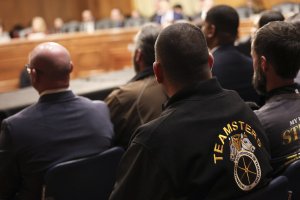
Members of the Teamster Union attended Lori Chavez-DeRemer’s nomination hearing on Feb. 19, 2025. (Josh Sukoff/MNS)
The daughter of a lifelong Teamsters member, the Oregon congresswoman is also a small-business owner and former mayor of a fast-growing suburb in the Portland metropolitan area. Now in President Trump’s orbit, Chavez-DeRemer is distancing herself from her past pro-union stance.
“In my district, unions aren’t the enemy of small businesses, they’re a partner. Small businesses benefit from the presence of unions. As a small business owner, I know this better than most,” Chavez-DeRemer said in a 2024 reelection ad.
Chavez-DeRemer recognized she was no longer an Oregon representative. If confirmed, she said she will commit to allowing Congress to write and enforce the laws as Labor Secretary.
“I will not be that lawmaker anymore,” she said in response to Sen. Cassidy.
Sen. Bernie Sanders, an independent from Vermont, implored the nominee to support working-class Americans.
“You will have to make a choice,” Sen. Sanders said. “Will you be a rubber stamp for the anti-worker agenda of Elon Musk, Jeff Bezos and other multi-billionaires…or will you stand with working families all over the country?”
Several Democratic senators expressed concerns over handing over sensitive labor data to billionaire Elon Musk’s Department of Government Efficiency allies. A federal judge on Tuesday denied a request by over a dozen states to block Musk allies from accessing information systems at the Labor Department and other federal agencies needed to fire federal workers.
As Sen. Andy Kim (D-N.J.) left the hearing, he said, “As of now, I haven’t been supportive of Trump’s cabinet nominees as long as this lawlessness effort that we’ve seen underway continues on.”
When pressed by Sen. Patty Murray (D-Wash.) about whether she would follow a Trump directive to violate labor laws, Chavez-DeRemer said, “I do not believe that the President is going to ask me to break the law.”
President Trump last week suggested that his administration could not be held liable for breaking any laws if they move in the country’s interests.
“He who saves his Country does not violate any Law,” he wrote in a now archived post on Truth Social and Musk’s X.
As he left the hearing, Sen. Josh Hawley (R-Mo.) reaffirmed his support for the nominee.
“And as I just reminded my Republican colleagues, she is the president’s choice to lead the labor department.”
Digital asset industry advocates against ‘regulation by enforcement’
WASHINGTON – House Republicans pressed to overhaul how the Securities and Exchange Commission regulates cryptocurrency at a hearing Tuesday, aligning themselves with the pro-cryptocurrency agenda President Donald Trump championed during the first few weeks of his administration.
The changes Republicans seek would create a new regulatory framework preferred by the cryptocurrency industry. Supporters of the overhaul said that past policies were “regulation by enforcement.” Cryptocurrency companies and owners have said previous regulations were outdated and did not match the developing nature of the technology.
This call from Republicans comes as Trump has enthusiastically embraced the crypto community, even releasing his own meme coin days before he assumed office. Just two days after being sworn in, Trump issued an executive order to establish a working group responsible for drafting new regulatory policy, signaling his determination to make the U.S. a hub for the cryptocurrency industry.
During the hearing, many Democratic lawmakers argued the modifications would put constituents at risk of fraud.
“The stories (about cryptocurrency) that stick with me the most are not on social media posts, they’re the ones I hear in my community,” Rep. Ayanna Pressley (D-Mass.) said. “Like the college student whose digital wallet had been drained and they don’t know who to turn to for help.
Rep. Pressley also told the story of an older constituent who was tricked into losing his money by an individual pretending to be his grandchild asking to set up a crypto access account.
“These stories and many more are the heartbreaking reality of crypto scams,” Pressley said.
However, Republican representatives reiterated that revising the regulatory framework would benefit both consumers and cryptocurrency companies by increasing transparency and facilitating an environment for technological growth.
“This lack of regulatory clarity not only hurt American investment but also impacted everyday Americans,” Rep. Bryan Steil (R-Wis.) said. “The Biden administration’s approach opened the door to bad actors and left consumers vulnerable to fraud.”
Several witnesses – which included executives from the Crypto Council for Innovation, Kraken Digital Asset Exchange, and Paypal – said the current regulatory framework had prompted many digital asset companies to move their operations overseas to other countries with friendlier policies.
“Other major jurisdictions have recognized we are in a race to the top in harnessing and benefiting from this new technology,” said Ji Hun Kim, the president and acting CEO of the Crypto Council for Innovation. “These jurisdictions are delivering exactly what the U.S. digital asset industry has been requesting: Regulatory clarity through a thoughtful, tailored regulatory regime that recognizes the potential of digital assets.”
Kim said the industry hopes to work alongside regulators to enhance clarity and boost U.S. leadership within the digital asset field. Kim and the other industry executives pushed for regulatory reforms during the hearing. One change would be to clarify whether cryptocurrencies count as securities, like stocks or bonds, or commodities, like grains or gold. That would clarify which agency would oversee cryptocurrency, they said.
Democratic representatives, however, expressed concern over the potential consequences of aligning the governmental regulations with the digital asset companies’ requests. Specifically, they emphasized the volatility of cryptocurrencies.
“I have deep concerns about opening the floodgates for non-bank companies to our payment system or for Fed accounts,” Rep. Stephen Lynch (D-Mass.) said. “Allowing crypto companies free rein could put pensions, retirement accounts, and other typically safe investment accounts at risk. The next crypto crash could have disastrous effects on the wider economy.”
Timothy Massad, the director of the Digital Assets Policy Project at Harvard’s Kennedy School of Government, affirmed the Democratic lawmakers’ notion that these policy changes could result in “a lot of consumer harm.”
Massad said that while there had been calls for “clarity” from the digital asset industry, there could be both bad rules and clarity simultaneously. He said the lack of a strong regulatory framework for the industry resulted in fraud, and he urged the committee to craft a stronger policy that “encourages responsible development of this technology.”
Industry advocates disputed that consumers would suffer from the proposals supported by Trump and congressional Republicans.
Jennifer Schulp, director for Financial Regulation Studies at the libertarian Cato Institute, told Medill News Service before the hearing that “clarity” on the business side of the industry would go “hand in hand” with clarity for consumers on what they are buying.
“Having a tailored disclosure regime for crypto securities would allow buyers to know the information that they’re entitled to and to get more standardized information from the projects that are issuing tokens,” Schulp said. “There’s benefits, not just for the companies, but there should be benefits for investors as well.”
Fed to hold rates steady, entering wait-and-see mode
WASHINGTON – After three consecutive rate cuts, Federal Reserve Chair Jerome Powell announced Wednesday the Fed will hold the federal funds rate constant at 4.25-4.50%.
During its first meeting of 2025, the Fed decided it would not act amidst “somewhat elevated” inflation and a “strong” economy as evidenced by the low unemployment rate.
“Right now, we feel like we’re in a very good place. Policy is well positioned. The economy is in quite a good place,” Powell said.
The Fed’s decision to hold rates comes after data from the Labor Department’s December Jobs Report showed a solid labor market, with jobs increasing by 256,000 and the unemployment rate falling to 4.1%. The Consumer Price Index, a general measure of inflation, rose to 2.9% in December. However, the core Consumer Price Index, an inflation measure that excludes volatile food and energy prices, fell to 3.2%.
Before September, the rates stood at 5.25-5.50%, the highest level in two decades, as the Fed worked to reduce inflation. The Fed had since cut rates by a full percentage point during its past three meetings when inflation showed signs of falling towards the Fed’s 2% goal and the labor market exhibited signals of weakness.
In response to the question of a March rate cut, Powell hinted that the committee did not “need to be in a hurry to adjust our policy stance.” He noted that inflation was on a “slow and sometimes bumpy” road. Powell said, however, that inflation did not need to fall to the Fed’s target before the committee cut rates again.
Powell faced questioning about whether the Fed would resist President Donald Trump’s demand that the Fed and Powell lower rates if Trump brought down oil prices. Powell reaffirmed the committee acts independently and that he had not communicated directly with Trump about his demands.
“Lots of research shows that’s the best way for a central bank to operate,” Powell said about the Fed’s independent role from the rest of the government. “That will give us the best possible chance to achieve these goals for the benefit of the American people. That’s always what we’re going to do, and people should have confidence in that.”
The meeting came at a time of high policy uncertainty. Powell mainly withheld comment on Trump’s actions as president. Recent executive orders from Trump regarding issues such as immigration, tariffs and regulatory policy had been at the center of economic debates on inflation and the job market. Trump critics have argued his tariffs and immigration policies could have an inflationary effect.
He said before the Fed can begin to make a “plausible assessment” of the policies’ implications, the committee needs to see the policies fully implemented.
Some economists believe these factors will be critical for the Fed to consider at future meetings.
“I think both (immigration and tariffs) will be important to decision-making going forward,” said Donald Kohn, a Senior Fellow for Economic Studies at Brookings.
Kohn said a crackdown on immigration will both reduce the workforce and simultaneously reduce the demand for certain goods and services, and it was unclear what the impact will be on prices. As for tariffs, he said they tend to raise prices for consumers but the dollar could strengthen as a result, which may partially offset price increases. Kohn noted the Fed would likely keep a close eye on this balance.
While investors and economists waited attentively for today’s meeting, the Fed’s move was expected.
“They are in wait-and-see mode, to collect more evidence about whether the downward drift in inflation resumes, how strong the labor market proves to be, and what economic policies the Trump Administration actually implements,” wrote David Wilcox, a senior fellow at the Peterson Institute for International Economics and Director for US Economic Research at Bloomberg in a statement to Medill News Service.


